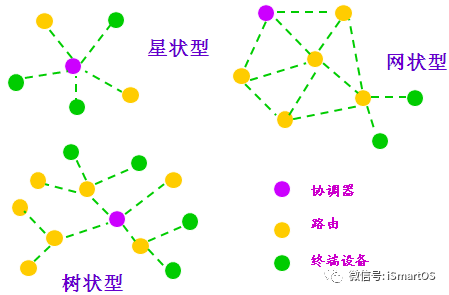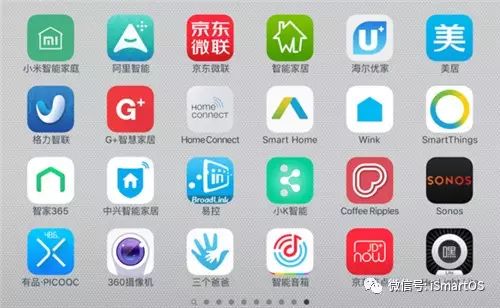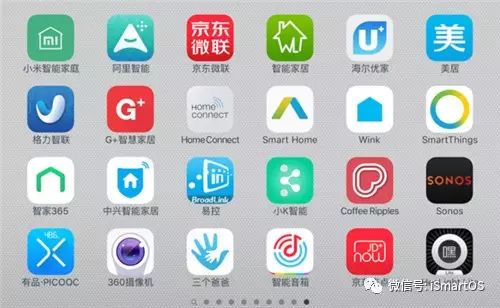In the field of smart hardware and the Internet of Things, the well-known ZigBee is indeed widely recognized. Apart from WiFi and Bluetooth, ZigBee is currently one of the most important wireless communication protocols, primarily applied in the fields of IoT and smart hardware. The following text introduces various aspects of ZigBee in a Q&A format. To put it modestly, you can basically learn everything you need to know about ZigBee here!
1. Origin and History
1What technology does ZigBee originate from?
During the use of Bluetooth technology, people discovered that although Bluetooth has many advantages, it also has many shortcomings. For industrial, home automation control, and industrial telemetry and remote control fields, Bluetooth technology is too complex, has high power consumption, short range, and small network scale. Meanwhile, the demand for wireless data communication in industrial automation is increasingly strong, and for industrial sites, such wireless data transmission must be highly reliable and able to withstand various electromagnetic interferences present in industrial environments. Therefore, after long-term efforts, the ZigBee protocol was officially launched in mid-2003. Additionally, ZigBee utilized the Home RF Lite communication protocol, which was studied before it.
2What is ZigBee?
Firstly, the MAC layer and PHY layer of ZigBee are based on the IEEE802.15.4 protocol. According to the specifications of this protocol, it is a bidirectional wireless communication technology characterized by short range, low complexity, low power consumption, low data rate, and low cost, mainly suitable for automatic control and remote control fields, and can be embedded in various devices while also supporting geographic positioning functions. The inventors of ZigBee vividly used the behavior of bees, which communicate the location and distance of pollen to their companions through their “dance” of flying and buzzing (zig), to metaphorically describe this wireless information transmission technology.
3What are the characteristics of ZigBee technology?
The characteristics of ZigBee include the following aspects:
(1) Low power consumption: In low-power standby mode, two AA batteries can support one node for 6-24 months, or even longer. This is a prominent advantage of ZigBee. In contrast, Bluetooth can work for several weeks, and WiFi can work for several hours;
(2) Low cost: By significantly simplifying the protocol, the cost is very low (less than 1/10 of Bluetooth), reducing the requirements for communication controllers. According to predictions, a full-function master node requires 32KB of code when calculated using an 8051 8-bit microcontroller, while a functional sub-node requires as little as 4KB of code, and ZigBee’s protocol is patent-free;
(3) Low data rate: ZigBee operates at a communication rate of 250kbps, meeting the application requirements for low data rate transmission;
(4) Short range: The transmission range generally lies between 10 to 100 meters, and can be extended to 1-3 km by increasing RF transmission power. This refers to the distance between adjacent nodes. If communication is relayed through routing and nodes, the transmission distance can be even further;
(5) Short delay: ZigBee has a fast response speed, typically taking only 15ms to switch from sleep to active state, and 30ms for a node to connect to the network, further saving energy. In comparison, Bluetooth takes 3-10s, and WiFi takes 3s;
(6) High capacity: ZigBee can adopt star, cluster tree, and mesh network structures, with one master node managing several sub-nodes, and a maximum of one master node can manage up to 254 sub-nodes; at the same time, the master node can also be managed by nodes from the upper layer network, allowing for the formation of a large network of up to 65,000 nodes;
(7) High security: ZigBee provides three levels of security modes, including no security settings, using access control lists (ACL) to prevent unauthorized data access, and employing Advanced Encryption Standard (AES128) symmetric encryption to flexibly determine its security attributes;
(8) License-free frequency bands: ZigBee operates in the Industrial, Scientific, and Medical (ISM) frequency bands, including 915MHz (USA), 868MHz (Europe), and 2.4GHz (global).
Due to the physical layer differences in these three frequency bands, each has different channel bandwidths of 0.6MHz, 2MHz, and 5MHz, respectively, with 1, 10, and 16 channels available. The spread spectrum and modulation methods of these three frequency bands also differ. All use Direct Sequence Spread Spectrum (DSSS) for spreading, but there are significant differences in the conversion from bits to chips. Modulation techniques use phase shift technology, with BPSK used for the 868MHz and 915MHz bands, while OQPSK is used for the 2.4GHz band.
At a transmission power of 0dBm, Bluetooth typically has a range of 10 meters. In contrast, ZigBee can generally reach 30-50 meters indoors and even up to 400 meters in open outdoor areas (without power amplification for TI CC2530).
Thus, ZigBee can be classified as a low data rate, short-range wireless communication technology.
4Why is ZigBee said to have emerged in response to the growing demand for reliable wireless data transmission in industrial automation?
ZigBee technology itself was developed because Bluetooth technology could not meet the requirements for low data volume, low cost, low power consumption, and high reliability in wireless data communication within industrial automation. For industrial sites, such wireless data transmission must be highly reliable and able to withstand various electromagnetic interferences present in industrial environments. ZigBee technology employs a mesh network topology, automatic routing, dynamic networking, and direct sequence spread spectrum to meet these needs in industrial automation control environments.

2. Communication Technology
1What protocol does ZigBee use?
ZigBee uses the IEEE802.15.4 protocol, which is a low-rate wireless PAN protocol. In terms of standardization, the IEEE802.15.4 working group is mainly responsible for developing the physical layer and MAC layer protocols, while other protocols mainly refer to and adopt existing standards. High-level applications, testing, and market promotion will be handled by the ZigBee Alliance.
2Why is the 2.4GHz frequency band used by ZigBee a free frequency band?
In China and most other countries worldwide, using radio equipment typically incurs frequency usage fees, including mobile communications. Mobile operators pay this fee to the state and charge users through number occupancy fees and other means. When using other wireless devices, you first need to apply for frequency usage permits from the relevant national departments, and fees are charged based on the frequency, power, and quantity of your wireless devices. This can amount to several thousand yuan annually for a single device. The free frequency band is designated by each country based on its actual situation and aims to align with other countries’ regulations as much as possible. This band is specifically for industrial, medical, and scientific research use (ISM band) and can be used without application. In China, the 2.4GHz band is such a band. However, to ensure reasonable use, the state has set power limits for wireless transmitting devices operating in this band, such as a maximum transmission power of 100mW in urban environments.
3Is ZigBee only suitable for short-distance communication?
ZigBee local area networks can not only expand by increasing the transmission power and receiving sensitivity of each node module and increasing the number of nodes, but they can also monitor remote ZigBee control networks through traditional Internet connections. However, when expanding, it is essential to consider:
(1) Increasing transmission power naturally increases power consumption, which may negate ZigBee’s advantage of low energy consumption;
(2) Although 2.4GHz is a free frequency band, it cannot exceed the maximum power limits specified in radio wave regulations.
4What are the benefits of ZigBee’s use of Direct Sequence Spread Spectrum communication?
The results of using different communication methods in the same frequency band can vary significantly, such as the anti-interference capabilities, communication security, and reliability of ASK, FSK, FHSS, DSSS, etc. The ZigBee system, like the CDMA system, employs Direct Sequence Spread Spectrum (DSSS), which is a highly anti-interference, secure, and reliable communication method. If you have used communication products based on these two technologies, you will find significant differences in their reliability.
Due to the low signal-to-noise ratio required for spread spectrum technology during normal communication, it can still function correctly even in environments with strong interference. Calculations and experiments suggest that this corresponds to a 7dBm increase in receiving sensitivity. It is also less likely to interfere with others. In other words, it can transmit over longer distances using lower power. Below are some references regarding the advantages of spread spectrum technology:
CDMA is a new type of digital cellular technology launched in 1995 after the introduction of digital communication technology worldwide. Utilizing digital transmission methods and spread spectrum communication technology, it significantly improves frequency utilization, featuring high capacity, broad coverage, low mobile device power consumption, and high voice quality, leading mobile communication technology into a new development phase. Compared to FDMA (Frequency Division Multiple Access) and TDMA (Time Division Multiple Access), CDMA systems have the following notable advantages:
(1) Good anti-interference performance: Due to the spread spectrum processing of CDMA, it has good anti-interference capabilities and can coexist with narrowband signals in the same frequency band without affecting normal operation.
(2) Strong multipath fading resistance: Multipath fading is a prominent issue affecting mobile communication quality, which usually requires techniques such as spatial diversity and adaptive equalization to overcome, with a significant fading margin. CDMA systems can utilize multipath signals to provide path diversity, alleviating Rayleigh fading and slow fading caused by physical obstructions, thereby greatly improving communication quality.
(3) Increased system capacity: For FDMA and TDMA, once the frequency points or time slots in a cell are allocated, the cell cannot accept new calls, leading to hard capacity limits. CDMA is an interference-limited system, meaning that at specified interference levels, even if the number of users reaches the limit, it still allows for additional users, albeit at the cost of reduced voice quality. Service providers can balance capacity and voice quality. CDMA’s precise power control and soft handover technology significantly reduce the strength of interference signals and the required signal-to-noise ratio, effectively employing techniques like voice activation, variable-rate voice encoding, diversity reception, and power control. Reports indicate that the signal-to-noise ratio for CDMA is 3.7 times that of DAMPS, 11.2 times that of TDMA, 13.6 times that of AMPS, and 20 times that of FM/FDMA.
(4) Good communication quality: CDMA systems adopt direct sequence spread spectrum technology, comprehensively applying time, frequency, space, and path diversity techniques to overcome multipath effects, achieving strong anti-interference capabilities. Furthermore, during inter-zone handovers, the soft handover technique ensures that CDMA maintains communication quality, especially during inter-zone transitions without ping-pong effects. This system is classified as broadband with low noise, allowing high redundancy error correction coding and efficient digital modulation techniques to ensure high-quality voice and data transmission.
(5) High frequency utilization: The same frequency can be reused across all cells in CDMA, with a frequency reuse rate of 2/3 (whereas FDMA and TDMA have a reuse rate of 1/7), eliminating the need for frequency allocation as in FDMA and TDMA, greatly simplifying cell splitting and microcell introduction.
(6) Strong multiple access capability: The multiple access capability of the CDMA system determines the size of multiple access interference between spread spectrum codes, which relates to the spread spectrum coding scheme used, the multiple access interference between users sending signals simultaneously (i.e., the correlation characteristics of spread spectrum codes), and the allowable receiving quality (output signal-to-noise ratio). Therefore, the lower the multiple access interference between users working simultaneously, the lower the allowable receiving quality, and the stronger the multiple access capability of CDMA technology.
(7) Highly reliable security: The CDMA mobile communication system is a secure communication system. If combined with certain encryption algorithms, it can significantly enhance communication confidentiality, which FDMA and TDMA systems cannot compare with. Analyzing its spread spectrum system, it is nearly impossible to intercept others’ communication content. As long as the internal lithium battery does not run out of power, it can change its sequence’s instantaneous state at a clock frequency of 512KHz, and even with continuous operation, its spread spectrum address sequence period lasts up to 7 years. It can also easily set and change master keys, sub-keys, spread spectrum code tables, and standard encryption algorithms in the CDMA system, making communication confidentiality even more reliable.
(8) Low mobile device power consumption: After power control is implemented, CDMA only increases transmission power levels during fading periods, thereby reducing average transmission power. The minimum power for FDMA is 5mW, average transmission power is 794 mW, and peak power is 3W, while CDMA’s minimum power is 2.3mW, average transmission power is 5mW, and peak power is 100mW. Thus, CDMA’s average and maximum transmission power is lower than FDMA, increasing system capacity, reducing the number of cells, and lowering equipment costs.
5What are the characteristics of ZigBee compared to existing data transmission radios?
Its advantages include:
(1) High reliability: The integration level of ZigBee modules is much higher than that of general data transmission radios, resulting in fewer discrete components and thus higher reliability;
(2) Convenient and secure usage: Due to high integration, ZigBee receiving modules can be made very small compared to general data transmission radios, and with low power consumption, the maximum transmission current is much lower than that of a CDMA mobile phone, making it easy to integrate or directly place into devices, not only convenient for use but also less prone to damage when carried outdoors;
(3) Strong anti-interference, good confidentiality, and low error rate: ZigBee transceivers use 2.4G direct sequence spread spectrum technology, which has better anti-interference capabilities and longer transmission distances than general FSK, ASK, and frequency hopping data transmission radios;
(4) Free frequency band: ZigBee operates in a free frequency band, while many data transmission radios require applications and annual fees to the national radio commission;
(5) Low price: The price of ZigBee data transmission modules is only a fraction of that of similar function data transmission radios.
6Why does ZigBee have better anti-interference performance than Wi-Fi and Bluetooth technologies?
According to recent research and related testing practices by Morlab Laboratory, the following points summarize the main reasons for ZigBee’s strong anti-interference capabilities.
ZigBee’s anti-interference characteristics mainly refer to resistance against co-frequency interference, that is, interference from other technologies operating in the same frequency band. The main characteristics are as follows:
1. Clear Channel Assessment (CCA):
This assesses whether the channel is idle. The IEEE 802.15.4 physical layer provides CCA capabilities within its collision avoidance mechanism, meaning that if the channel is occupied by other devices, transmission is allowed to exit without needing to consider using that channel’s communication protocol.
There are currently three modes of idle channel assessment:
(1) Assessing the signal energy of the channel; if the signal energy is below a certain threshold, the channel is considered idle;
(2) Assessing the characteristics of the wireless channel, mainly including two aspects, namely spread spectrum signals and carrier frequency;
(3) A combination of the first two modes, simultaneously detecting signal strength and characteristics to make a judgment on channel idleness.
2. Dynamic channel selection:
The coordinator in a ZigBee personal area network (PAN) (the central node responsible for organizing and maintaining the network) first scans all channels, then confirms and joins a suitable PAN (without needing to create a new PAN), reducing the number of co-frequency PANs and lowering potential interference. If an interference source appears on overlapping channels, the coordinator’s upper-level software applies channel algorithms to select a new channel.
3. Channel algorithms:
During network initialization or in response to interruptions, ZigBee devices will scan a series of channels listed in the channel table parameters for dynamic channel selection, setting the channel table parameters according to the idle channel assessments to enhance network coexistence performance.
During severe interference, ZigBee does not change channels; instead, it relies on its low duty cycle and conflict-free algorithms (where each device listens to the channel before sending data) to minimize data loss caused by transmission conflicts.
4. Direct Sequence Spread Spectrum (DSSS) and Frequency Hopping:
The direct sequence spread spectrum technology has certain anti-interference effects (as shown in the figure below). Under the same conditions, the transmission distance is greater than hopping technology (with Bluetooth having a 10m effective range at 0dBm transmission power, while ZigBee can reach 30-50m indoors). The so-called frequency hopping is changing frequency to avoid the influence of known interference sources or signal sources.
As seen in the figure below, ZigBee’s error rate can reach 10-9 at a signal-to-noise ratio of 4dB, while Wi-Fi requires 10dB and Bluetooth as high as 16dB to achieve the same error rate, clearly demonstrating ZigBee’s superior anti-interference performance over Wi-Fi and Bluetooth technologies.
5. Acknowledgment re-transmission and frame buffering:
ZigBee’s MAC layer and application layer (APS part) have automatic request re-transmission (ARQ) and frame buffering capabilities. When sending a data frame to a device, if the receiving device is busy or in sleep mode and cannot receive the frame, the network’s main coordinating device temporarily buffers the frame until the receiving end can accept it.
Although the modulation method is simple, ZigBee demonstrates excellent anti-interference performance in the 2.4GHz ISM band, making it very suitable for low-power, low-data transmission applications. Currently, ZigBee products mainly adopt EN300328 testing standards for CE certification, while in the FCC, they mainly use Part 15C testing.
3. Network Technology
1What kind of wireless data transmission network does ZigBee have?
In simple terms, ZigBee is a highly reliable wireless data transmission network, similar to CDMA and GSM networks, where ZigBee data transmission modules resemble mobile network base stations. Communication distances range from a standard 75 meters to several hundred meters or kilometers, and wireless expansion is supported.
ZigBee is a wireless data transmission network platform consisting of up to 65,000 wireless data transmission modules, very similar to existing mobile communication CDMA or GSM networks, where each ZigBee data transmission module acts like a mobile network base station, allowing mutual communication across the entire network range; the distance between each network node can range from the standard 75 meters to several hundred meters, or even kilometers when expanded.
Unlike mobile communication CDMA or GSM networks, ZigBee networks are primarily established for data transmission in industrial automation control, hence they must be simple, user-friendly, reliable, and low-cost. In contrast, mobile communication networks are mainly established for voice communication, with each base station generally costing over a million yuan, while each ZigBee “base station” costs less than 1,000 yuan. Each ZigBee network node can not only serve as a monitoring object, such as directly collecting and monitoring data from connected sensors, but can also automatically relay data from other network nodes. Additionally, each ZigBee network node (FFD) can wirelessly connect to multiple isolated sub-nodes (RFD) within its signal coverage area without undertaking network information relay tasks.
Each ZigBee network node (FFD and RFD) can support up to 31 sensors and controlled devices, with each sensor and controlled device potentially having eight different interface methods. They can collect and transmit both digital and analog quantities.
2What is ZigBee’s self-organizing network?
A simple example can illustrate this issue: when a team of paratroopers lands, each armed with a ZigBee network module terminal, once they land, as long as they are within each other’s communication range, they can quickly form an interconnected ZigBee network by automatically searching for each other. They cannot predict who is where, and due to personnel movement, their connections may change. Therefore, the modules can also refresh the original network by re-searching communication targets. This is what self-organizing networks are.

3Why does ZigBee use a self-organizing network for communication?
Mesh network communication is essentially multi-channel communication. In actual industrial sites, due to various reasons, it often cannot guarantee that every wireless channel remains unobstructed, similar to city streets, where traffic may be temporarily disrupted due to accidents or road repairs. In this case, having multiple channels allows vehicles (equivalent to our control data) to still reach their destination via alternative routes. This is crucial for industrial control.
4Why does the self-organizing network adopt dynamic routing?
Dynamic routing means that the path for data transmission within the network is not pre-set, but rather searched and analyzed based on all available paths at the time of data transmission, considering their positional relationships and distances, then selecting one of the paths for data transmission.
In our network management software, the path selection uses a “gradient method,” meaning it first selects the nearest available path for transmission, and if that fails, it uses a slightly farther route, continuing this process until the data reaches its destination.
In actual industrial sites, pre-determined transmission paths can change at any time due to various reasons, or they may be interrupted or too busy for timely transmission. Dynamic routing, combined with mesh network topology, can effectively solve this problem, ensuring reliable data transmission.
Smart home industry communication group: 80748603
1How does ZigBee compare to existing mobile communication networks (GPRS, CDMA-1X)?
The characteristics are:
(1) No network usage fees: Using mobile networks requires long-term payments for network usage fees, calculated by the number of node terminals, whereas ZigBee has no such fees;
(2) Low equipment investment: Using mobile networks requires purchasing mobile terminal devices, each priced around 1,000 yuan, while using ZigBee networks not only costs less than 1,000 yuan for each ZigBee network node module (equivalent to a base station), but the prices of the main network sub-nodes (equivalent to mobile phones) are even lower;
(3) More reliable communication: Existing mobile networks are primarily designed for mobile phone communication; although CDMA-1X and GPRS can perform data communication, practical experience shows that both the communication speed and reliability of data transmission often fail to meet expectations. In contrast, ZigBee networks are specifically designed for controlling data transmission, ensuring a high level of reliability;
(4) High flexibility and low cost: By using ZigBee network nodes with different coverage distances and functions, along with low-cost wireless transceiver modules from non-ZigBee systems, a local ZigBee automation control network can be established, which can then connect to remote computers via the Internet or mobile networks, achieving low-cost and efficient industrial automation telemetry and remote control;
(5) Although ZigBee is only a local area network, it can “infinitely” expand its coverage through sufficient data outlets and can connect with existing mobile networks, the Internet, and other communication networks, linking multiple ZigBee local area networks into a whole. This effectively solves the blind spot coverage problem of mobile networks; we know that existing mobile networks have many blind spots, especially in remote areas like railways, highways, oil fields, and mines. Increasing a mobile base station or repeater can be quite costly, making the use of ZigBee networks for blind spot coverage not only economically effective but often the only viable option.
6How does ZigBee achieve long-distance telemetry and remote control?
ZigBee networks can also connect to the Internet, GPRS networks, CDMA1x networks, and other communication systems through interface cards and various means to achieve remote control. You can also connect two or more local ZigBee networks through other networks.
4. Market Applications
1What application fields does ZigBee technology cover?
The goal of ZigBee technology is to target industrial and home automation, telemetry and remote control, such as lighting automation control, wireless data collection and monitoring of sensors, oil fields, electricity, mining, and logistics management applications.
2What requirements for wireless data transmission in industrial sites does ZigBee meet?
Requirements include low power consumption, low data volume (250KPS), low cost, the use of free ISM frequency bands (2.4G), high anti-interference performance through direct sequence spread spectrum communication (DSSS), high confidentiality (64-bit factory serial number and support for AES-128 encryption), high integration, and high reliability; node modules have automatic dynamic networking capabilities, employing topologies including mesh networks, and use collision avoidance mechanisms to ensure reliable information transmission throughout the ZigBee network.
3In what areas can ZigBee expand its applications?
ZigBee has a very broad application range, targeting industrial automation, home automation, telemetry and remote control, automotive automation, agricultural automation, healthcare, oil fields, electricity, mining, and logistics management, among others.
Examples of practical applications include lighting control, environmental control, automatic meter reading systems, various curtain controls, smoke sensors, medical monitoring systems, large air conditioning systems, set-top boxes with built-in home control, universal remote controls, heating control, home security, and industrial and building automation. Additionally, it can also locate mobile targets, such as vehicles in urban areas.
4What conditions must short-distance communication meet to consider using ZigBee technology?
Typically, short-distance communication that meets one of the following conditions can consider applying ZigBee:
(1) Many points require data collection or monitoring;
(2) The amount of data to be transmitted is small, while low device cost is required;
(3) High reliability and security of data transmission are required;
(4) Devices must be very compact, making it inconvenient to place larger rechargeable batteries or power modules;
(5) Battery power supply is feasible;
(6) Complex terrain with many monitoring points requiring extensive network coverage;
(7) Covering blind spots in existing mobile networks;
(8) Remote telemetry and control systems that already use existing mobile networks for low data volume transmission.
5What is the application status of ZigBee technology in China?
Although many people in China have begun to pay attention to ZigBee technology and numerous companies have started to engage in its development, considering that ZigBee itself is a new system integration technology, developing application software requires a combination of network transmission, radio frequency technology, and underlying software and hardware control technology, posing certain technical challenges for initial development companies. Due to various constraints, the large-scale commercial application of ZigBee technology is still pending.
However, it has already demonstrated extraordinary application value, and it is believed that with the development and promotion of related technologies, it will gain even greater application. We must also clearly recognize that wireless networks based on ZigBee technology are just beginning to develop, and their technology and applications are far from mature. Domestic companies should seize the opportunity, increase investment, and promote the development of the entire industry.
5. ZigBee Alliance
1What is the mission of the ZigBee Alliance?
The ZigBee Alliance is a rapidly growing non-profit industry organization, comprising internationally renowned semiconductor manufacturers, technology providers, integrators, and end users. The Alliance has established specifications for network applications based on IEEE802.15.4, emphasizing high reliability, cost-effectiveness, and low power consumption.
2What are the goals of the ZigBee Alliance?
The main goal of the ZigBee Alliance is to provide consumers with more flexible and user-friendly electronic products by incorporating wireless networking capabilities. ZigBee technology can be integrated into various electronic products, with applications spanning global consumer, commercial, public utility, and industrial markets, allowing alliance members to leverage the standardized ZigBee wireless network platform to design simple, reliable, cost-effective, and energy-efficient products.
3What are the focal points of the ZigBee Alliance?
Its focus includes developing network, security, and application software layers; providing specifications for interoperability and compatibility testing of different products; promoting the ZigBee brand worldwide and garnering market attention; and managing technology development.
4What work has the ZigBee Alliance done regarding standards?
ZigBee standards development includes the physical layer, MAC layer, and data link layer of IEEE802.15.4, which was released in May 2003. Significant progress has also been made in developing the ZigBee network layer, encryption layer, and application description layer, with version 1.0 released. Other application domains and related device descriptions will be released subsequently. Since ZigBee is not merely a synonym for 802.15.4, and IEEE only handles low-level MAC layer and physical layer protocols, the ZigBee Alliance has standardized its network layer protocols and APIs. The complete protocol is used for a basic node that can connect directly to one device with 4K bytes or as a coordinator or router with 32K bytes. Each coordinator can connect up to 255 nodes, and multiple coordinators can form a network without limits on the number of routed transmissions. The ZigBee Alliance has also developed a security layer to ensure that portable devices do not accidentally leak their identifiers and that long-distance transmissions over the network are not intercepted by other nodes.
The ZigBee Alliance emphasizes device interoperability: many short-range electronic products embedded with ZigBee modules already possess ZigBee functionality, and many various products reserve ZigBee interfaces for future upgrades.
5Which companies are members of the ZigBee Alliance’s board?
Sixteen companies have joined the ZigBee Alliance as “promoters” and board members:
-
Comcast Cable
-
Itron Inc.
-
The Kroger Co.
-
Landis+Gyr
-
Legrand Group
-
Midea Group
-
NXP Semiconductors
-
Philips
-
Schneider Electric
-
Silicon Labs
-
SmartThings
-
SOMFY
-
Texas Instruments
-
Wulian
-
Huawei
-
LEEDARSON
6Who are the executives of the ZigBee Alliance?
The Chairman and CEO of the ZigBee Alliance: Tobin Richardson.
Chairman of the ZigBee Alliance Board: John E. Osborne II (LEEDARSON)
Vice Chairmen of the ZigBee Alliance Board:
-
Jean-Pierre Desbenoit (Schneider Electric)
-
Hans Dollee (NXP Semiconductors)
-
Musa Unmehopa (Philips Lighting)
-
Bruno Vulcano (Legrand Group)
-
David Randolph Hoelscher (Huawei)
-
Juston Zhu (Wulian) (the first Chinese vice-chairman and the first Asian vice-chairman)
Treasurer of the ZigBee Alliance: Jean-Michel Orsat (SOMFY)
Secretary of the ZigBee Alliance Board: Michael Koster (Samsung/SmartThings)
Source: http://www.zigbee.org/zigbeealliance/board-and-officers-chinese/
6. ZigBee 3.0 Technology
An article from Geek Park titled “Why do I need so many apps to control my smart appliances?” has sparked considerable discussion in the smart home sector, directly addressing the pain point of different manufacturers’ products not being interoperable. The article points out that the multitude of apps in the smart home industry creates significant confusion for users. If users want to use smart devices produced by different manufacturers, they must purchase different smart home gateway devices and use various manufacturers’ apps to control these devices, greatly diminishing user enthusiasm for purchasing and using smart home products. So what is the fundamental reason for the lack of interoperability in smart homes? It all begins with the smart home industry chain.

1The Smart Home Industry Chain and Interoperability
The smart home industry chain consists of protocol (or standard) providers, IC chip manufacturers (often also software protocol stack providers), solution providers, and smart home product manufacturers. We will primarily discuss the source protocols in the smart home industry chain.
The mainstream protocols in smart homes mainly include: Wi-Fi, ZigBee, and Z-Wave.
Wi-Fi Protocol is not widely applicable to smart home devices due to high power consumption, relatively complex networking, and fewer nodes. However, due to Wi-Fi’s high transmission rate, it is very suitable for applications such as smart cameras. Therefore, Wi-Fi primarily serves as a supplementary protocol in smart homes.
Z-Wave Protocol has been widely adopted in Europe due to its low cost, low power consumption, high reliability, suitability for short-distance wireless communication, and high interoperability. Z-Wave gateways can control devices from different manufacturers based on the Z-Wave protocol. However, since Z-Wave operates in the frequency range of 908.42MHz (USA) to 868.42MHz (Europe), this range is classified as an industrial band in China, making Z-Wave virtually non-applicable domestically.
ZigBee Protocol has become the most widely used protocol in the smart home industry due to its low power consumption, mesh networking capabilities, numerous nodes, and high security. Unfortunately, the biggest issue with ZigBee is its poor interoperability; although different manufacturers use ZigBee, they cannot control one another’s devices.

2The Past and Present of ZigBee
The ZigBee protocol was born out of the demand for industrial IoT. To meet different application contexts, the ZigBee Alliance has issued various application layer protocols such as ZigBee Home Automation (ZigBee HA), ZigBee Light Link (ZigBee LL), ZigBee Building Automation (ZigBee BA), ZigBee Retail Services (ZigBee RS), ZigBee Health Care (ZigBee HC), and ZigBee Telecommunication Services (ZigBee TS) to cater to smart home, smart lighting, smart buildings, smart retail, smart healthcare, and smart communication services.

The problem is that these application layer protocols are independent and non-interoperable. Due to poor standardization in early versions of ZigBee, manufacturers had too many choices. Many manufacturers adopted the ZigBee HA protocol, but terminal manufacturers customized it according to their needs, resulting in non-standard ZigBee protocols, which led to incompatibility between products from different manufacturers. This situation is somewhat similar to Android, where different phone manufacturers use the Android system but have made extensive customizations, resulting in vastly different phone systems.
The ZigBee Alliance has also struggled with the standardization of ZigBee HA; therefore, they have organized a group of organizations to perform ZigBee HA certification, such as the latest ZigBee HA1.2 certification, which ensures that products certified under ZigBee HA1.2 can achieve interoperability.
The fundamental reason for the lack of interoperability in smart homes is that the most widely used ZigBee protocol has many application layer protocols that are independent and non-interoperable; additionally, even when using the same application layer protocol, incompatibility may arise due to standardization issues. It can be said that ZigBee has only addressed the connection issue of smart devices but has not resolved the interoperability issue between smart devices.
3ZigBee 3.0 to Solve Smart Home Interoperability!
In May 2016, the ZigBee Alliance, along with members of the ZigBee Alliance in China, held a press conference and ribbon-cutting ceremony at the Asia Consumer Electronics Show (CES Asia), officially launching ZigBee 3.0 in the Asian market. IC manufacturers such as TI, NXP, GreenPeak, and Atmel, solution providers like Wulian, and major smart home manufacturers like Philips and Midea participated in the press conference.
The primary task of ZigBee 3.0 is to unify the ZigBee Home Automation (ZigBee HA), ZigBee Light Link (ZigBee LL), ZigBee Building Automation (ZigBee BA), ZigBee Retail Services (ZigBee RS), ZigBee Health Care (ZigBee HC), and ZigBee Telecommunication Services (ZigBee TS) application layer protocols, solving the interoperability issue between different application layer protocols. Users only need to purchase any gateway certified under ZigBee 3.0 to control various smart devices from different manufacturers based on ZigBee 3.0.
ZigBee 3.0 standardized the discovery, joining, and networking methods of ZigBee devices using different application layer protocols, making ZigBee networking more convenient and unified. Additionally, ZigBee 3.0 further strengthened the security of ZigBee networks.
Somewhat regrettably, ZigBee 3.0 did not unify the ZigBee Smart Energy application layer protocol. The ZigBee application layer protocol is used to read the power data from electricity meters, for example, smart homes using ZigBee Smart Energy can know their electricity consumption monthly, weekly, or even daily. Property management companies and electric companies can monitor each household’s power consumption in real-time for billing purposes. The ZigBee Alliance has also introduced ZigBee 3.0 certification to standardize manufacturers’ use of the standard ZigBee 3.0 protocol to ensure interoperability among devices based on ZigBee 3.0.
3How do smart home industry players view ZigBee 3.0?
ZigBee 3.0 has solved the interoperability problem between different application layer protocols of the most mainstream protocol in the smart home field, taking a significant step toward interoperability in smart homes. However, further efforts are needed to achieve interoperability with other protocols. This requires cooperation and compromise among different protocol (or standard) providers at the foundational level, a process that may be quite challenging. Currently, the best solution may be that smart home manufacturers’ gateway devices support multiple protocol standards, providing a unified user interface for interaction.
Wulian has launched the WLink platform to establish connections with technologies like Wi-Fi and Bluetooth through mutually beneficial cooperation, quickly upgrading traditional lighting, locks, home appliances, and achieving interoperability between smart products.
The WLink platform is an open IoT smart home platform centered around the WLink super gateway, supporting devices with ZigBee, Wi-Fi, Ethernet, and other protocols, providing personalized solutions including terminal hardware, communication modules, software applications, and cloud services. At AWE2016, the WLink platform exhibition area set up in the Wulian exhibition hall gathered several well-known home appliance manufacturers, including Haier, Skyworth, Hisense, TCL, Joyoung, and Midea.
By early 2017, all series of Haier products had completed integration with 《Haier Smart Home Introduction and User Guide》, and currently, products from companies that have partnered with the WLink platform include: the entire Haier product line, Midea central air conditioning, drying racks, Honeywell smoke detectors, Ningbo Xiangwang background music systems, Dogtail Xiaobai robots, Luko smart locks, Figaro gas detectors, etc., with more products in the integration process, and further deep collaborations are expected with more companies and their products.








